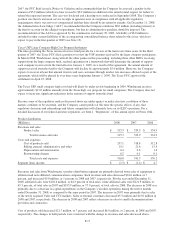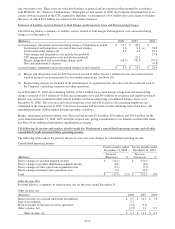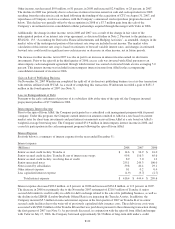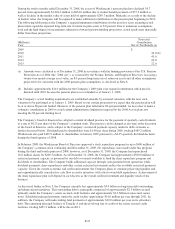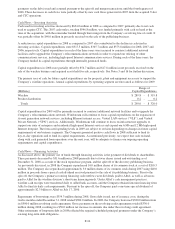Windstream 2008 Annual Report Download - page 115
Download and view the complete annual report
Please find page 115 of the 2008 Windstream annual report below. You can navigate through the pages in the report by either clicking on the pages listed below, or by using the keyword search tool below to find specific information within the annual report.
In addition, the Company has exposure to market risk through the Company’s pension plan investments. The fair
market value of these investments, totaling $654.0 million at December 31, 2008, declined 34.7 percent from
approximately $1,001.0 million at December 31, 2007, due to benefit payments as well as a 28.9 percent decline in the
market value of assets held. Primarily as a result of the decline in the market value of pension assets, the Company will
recognize pension expense of $90.4 million in 2009 as compared to a benefit of $1.6 million in 2008.
Windstream’s pension plan utilizes various investment managers, five of whom invest in fixed income securities. As of
December 31, 2008, these five managers collectively manage approximately 60 percent of Windstream’s pension
assets, totaling approximately $393.5 million. Of this amount, approximately $46.3 million, is invested in collateralized
mortgage obligations (“CMO’s”) and asset backed securities (“ABS”), of which approximately $6.8 million are
sub-prime securities. These investments, totaling 7.1 percent of pension assets, are substantially all in funds that
currently hold an investment grade rating. Windstream’s pension assets have no exposure to either collateralized loan
obligations or collateralized debt obligations. Of the CMO exposure, the investment managers have focused on prime
mortgage holdings and securities with relatively short terms, all of which are securitized by mortgages. Furthermore,
the vast majority of these investments relate to the most senior secured tranches, which are the highest rated and the
highest priority for retirement.
As previously discussed in Liquidity and Capital Resources, management estimates that the Company will be required
to contribute approximately $24.0 million, net of tax benefit, to the pension plan in 2010. See the “Pension and Other
Postretirement Benefits” caption below in our discussion of critical accounting policies and estimates for the results of
the sensitivity analysis.
Foreign Currency Risk
Although the Company does not operate in foreign countries, the Windstream pension plan invests in international
securities. Windstream has a well diversified pension plan, with a target asset allocation for international investments
of 15 to 20 percent of the total pension assets. As of December 31, 2008 approximately $96.1 million or 14.7 percent of
total pension assets are invested in debt or equity securities denominated in foreign currencies. The investments are
diversified in terms of country, industry and company risk, limiting the overall foreign currency exposure.
Critical Accounting Policies and Estimates
We prepare our consolidated financial statements in accordance with accounting principles generally accepted in the
United States. Our significant accounting policies are discussed in detail in Note 2. Certain of these accounting policies
as discussed below require management to make estimates and assumptions about future events that could materially
affect the reported amounts of assets, liabilities, revenues and expenses and disclosure of contingent assets and
liabilities. We believe that the estimates, judgments and assumptions made when accounting for the items described
below are reasonable, based on information available at the time they are made. However, there can be no assurance
that actual results will not differ from those estimates.
Revenue Recognition – We recognize revenues and sales as services are rendered or as products are sold in accordance
with Staff Accounting Bulletin (“SAB”) No. 104, “Revenue Recognition”.Service revenues are primarily derived from
providing access to or usage of the Company’s networks and facilities. Due to varying customer billing cycle cut-off
times, the Company must estimate service revenues earned but not yet billed at the end of each reporting period. Sales
of communications products, including customer premise equipment and modems, are recognized when products are
delivered to and accepted by customers. Fees assessed to communications customers to activate service are not a
separate unit of accounting and are deferred upon activation and recognized as service revenue on a straight-line basis
over the expected life of the customer relationship in accordance with Emerging Issues Task Force Issue No. (“EITF”)
00-21 “Revenue Arrangements with Multiple Deliverables”. The direct costs associated with activating such services,
up to the related amount of deferred revenue, are deferred and recognized as an operating expense over the same
period.
The Company recognizes certain revenues pursuant to various cost recovery programs from state and federal Universal
Service Funds, and from revenue sharing arrangements with other local exchange carriers administered by the National
Exchange Carrier Association. Revenues are calculated based on the Company’s investment in its network and other
network operations and support costs. The Company has historically collected the revenues recognized through this
program; however, adjustments to estimated revenues in future periods are possible. These adjustments could be
necessitated by adverse regulatory developments with respect to these subsidies and revenue sharing arrangements,
changes in the allowable rates of return, the determination of recoverable costs, or decreases in the availability of funds
in the programs due to increased participation by other carriers.
Allowance for Doubtful Accounts – In evaluating the collectibility of our trade receivables, we assess a number of
factors, including a specific customer’s ability to meet its financial obligations to us, as well as general factors, such as
F-27


